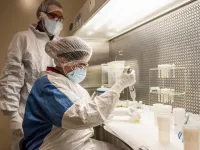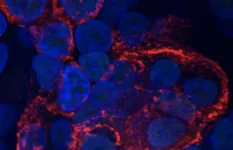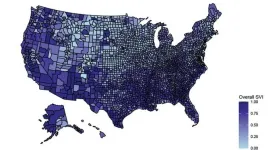(Press-News.org) RICHLAND, Wash.?Unless radon gas is discovered in a home inspection, most people remain blissfully unaware that rocks like granite, metal ores, and some soils contain naturally occurring sources of radiation. In most cases, low levels of radiation are not a health concern. But some scientists and engineers are concerned about even trace levels of radiation, which can wreak havoc on sensitive equipment. The semiconductor industry, for instance, spends billions each year to source and "scrub" ultra-trace levels of radioactive materials from microchips, transistors and sensitive sensors.
Now chemists at the U.S. Department of Energy's Pacific Northwest National Laboratory have developed a simple and reliable method that holds promise for transforming how ultra-trace elements are separated and detected. Low levels of troublesome naturally occurring radioactive elements like uranium and thorium atoms are often tucked among valuable metals like gold and copper. It has been extraordinarily difficult, impractical, or even impossible, in some cases, to tease out how much is found in samples of ore mined across the globe.
Yet sourcing materials with very low levels of natural radiation is essential for certain types of sensitive instruments and detectors, like those searching for evidence of currently undetected particles that many physicists believe actually comprise most of the universe.
"We are really pushing the envelope on detection," said chemist Khadouja Harouaka. "We want to measure very low levels of thorium and uranium in components that go into some of the most sensitive detectors in the world. It is particularly difficult to measure low levels of thorium and uranium in precious metals like the gold that goes into the electrical components of these detectors. With this new technique, we can overcome that challenge and achieve detection limits as low as 10 parts per trillion in gold."
That's like trying to find one four-leaf clover in about 100 thousand acres of clover?an area larger than New Orleans.
Colliding worlds of particles
The scientists locate their extraordinarily rare "four-leaf clover" atoms from the huge field of ordinary atoms by sending their samples through a series of isolation chambers. These chambers first filter and then collide the rare atoms with simple oxygen, creating a "tagged" molecule of a unique molecular weight that can then be separated by its size and charge.
The effect is like finding a way to tie a helium balloon to each target thorium or uranium atom so that it floats above the sea of gold sample and can be counted. In this case, the sophisticated counter is a mass spectrometer. The research is featured on the cover of the December 2020 issue of Journal of Analytical Atomic Spectrometry.
The central innovation is the collision cell chamber, where charged atoms of thorium and uranium react with oxygen, increasing their molecular weight and allowing them to separate from other overlapping signals that can disguise their presence.
"I had an aha moment," said Greg Eiden, the original PNNL inventor of the patented collision cell, which is used to perform these reactions, thereby reducing unwanted interference in the instrument readout by a factor of a million. "It was this miracle chemistry that gets rid of the bad stuff you don't want in your sample so you can see what you want to see."
In the current study, Harouaka and her mentor Isaac Arnquist leveraged Eiden's work to tease out the vanishingly small number of radioactive atoms that can nonetheless ruin sensitive electronic detection equipment.
Among other uses, the innovation may allow chemists, led by senior chemist Eric Hoppe and his team at PNNL, to further hone the chemistry that produces the world's purest electroformed copper. The copper forms a key component of sensitive physics detectors, including those used for international nuclear treaty verification.
Neutrino listening tour
Stanford physicist Giorgio Gratta helps lead a global quest to capture evidence for the fundamental building blocks of the universe. The nEXO experiment, now in the planning stages, is pushing the detection boundaries for evidence of these elusive particles, called Majorana Fermions. The signals they seek come from exceedingly rare events. To detect such an event, the experiments require exquisitely sensitive detectors that are free of stray radiation pings introduced through the materials that make up the detector. That includes the metals in the electronics required to record the exceedingly rare events that trigger detection.
"PNNL is a global leader in ultra-trace radiation detection," said Gratta. "Their unique mix of innovation and application provide an important contribution that enables sensitive experiments like nEXO."
Physicist Steve Elliott of Los Alamos National Laboratory emphasized the lengths to which researchers must go to ensure a scrupulously clean environment for rare particle detection.
"In experimental programs where even human fingerprints are too radioactive and must be avoided, techniques to measure ultra-low radioactive impurity levels are critical," he said, adding that this method could provide an important way to source materials for another of the next generation of rare neutrino event detectors, called LEGEND, being planned for deployment in an underground location in Europe.
Cleaning semiconductors and quantum computers
Semiconductors, the basic building blocks of modern electronics, including integrated circuits, microchips, transistors, sensors and quantum computers are also sensitive to the presence of stray radiation. And the innovation cycle demands each generation pack more and more into ever tinier microchips.
"As the architecture gets smaller and smaller, radiation contamination is an ever-bigger issue that manufacturers have been working around by changing the architecture inside the chips," said Hoppe. "But there's only so far you can go with that, and you really start to become limited by the purity of some of those materials. The industry has set targets for itself that right now it can't achieve, so having a measurement technique like this could make some of those targets achievable."
More broadly, Eiden added, "in the big world of the periodic table there's probably applications for any element that you care about. And what Eric, Khadouja and Isaac are going after here is analyzing any trace impurity in any ultra-pure material."
INFORMATION:
The research was supported by Laboratory Directed Research and Development funds under the Nuclear Physics, Particle Physics, Astrophysics, and Cosmology Initiative.
Pacific Northwest National Laboratory draws on signature capabilities in chemistry, Earth sciences, and data analytics to advance scientific discovery and create solutions to the nation's toughest challenges in energy resiliency and national security. Founded in 1965, PNNL is operated by Battelle for the U.S. Department of Energy's Office of Science. DOE's Office of Science is the single largest supporter of basic research in the physical sciences in the United States and is working to address some of the most pressing challenges of our time. For more information, visit the PNNL's News Center. Follow us on Facebook, LinkedIn, Twitter, and Instagram.
What if scientists knew exactly what impact the SARS-CoV-2 virus had inside our lung cells, within the first few hours of being infected? Could they use that information to find drugs that would disrupt the virus' replication process before it ever gets fully underway? The discovery that several existing FDA-approved drugs--including some originally designed to fight cancer--can stop coronavirus in its tracks indicates the answer is a resounding yes.
A team of Boston University researchers--hailing from BU's National Emerging Infectious Diseases Laboratories ...
Philadelphia, January 29, 2021--Researchers at Children's Hospital of Philadelphia (CHOP) have developed a gene therapy vector for blood disorders like sickle cell disease and beta-thalassemia that is potentially safer and more effective than those currently used in gene therapy trials for those conditions. The vector, an engineered vehicle for delivering functional copies of the hemoglobin gene to correct a genetic abnormality, leads to the production of more hemoglobin with a lower dose, minimizing the risk of toxic side effects.
The findings were published today in Molecular Therapy.
"These results have many potential benefits for the successful treatment of patients ...
PITTSBURGH, Jan. 29, 2021 - A study led by UPMC Children's Hospital of Pittsburgh and the University of Pittsburgh School of Medicine shows that Black children are 18% less likely to get imaging tests as part of their emergency department visit compared to White children. Hispanic children are 13% less likely to have imaging done than Whites.
The researchers suggest that this disparity results from overuse in White children, though underuse in minority children probably plays a part as well. The root cause likely stems from both patient preferences and implicit bias among providers.
"Something else is going on here that's beyond the clinical, that's beyond the diagnoses," said study lead author Jennifer Marin, M.D., M.Sc., associate ...
In just one year, COVID-19 has killed more than 400,000 Americans, and infected more than 24 million others. But a new study shows just how unevenly those deaths and cases have played out across the country.
It finds that the more disadvantaged a county's population was before the pandemic, the higher the toll of coronavirus last spring and summer.
That level of disadvantage, measured on a standard scale called the Social Vulnerability Index (SVI), tracked closely with the number of cases and deaths per 100,000 residents in each county, according to the new University of Michigan study.
The ten-point SVI score combines many measures of the social disadvantage of a county's population, with higher scores meaning greater disadvantage. For every ...
What The Study Did: Maternally derived antibodies are a key element of neonatal immunity. This study examined the association between maternal and neonatal SARS-CoV-2-specific antibody concentrations because understanding the dynamics of maternal antibody responses to SARS-CoV-2 infection during pregnancy and subsequent transplacental antibody transfer can inform neonatal management as well as maternal vaccination strategies.
Authors: Scott E. Hensley, Ph.D., of the University of Pennsylvania in Philadelphia, and Karen M. Puopolo, M.D., Ph.D., of the Children's Hospital of Philadelphia, are the corresponding authors.
To ...
What The Study Did: Researchers investigated the association between county-level social risk factors and COVID-19 cases and deaths, as well as weekly changes in cumulative cases and mortality, using publicly available data sets as of July 29, 2020.
Authors: Renuka Tipirneni, M.D., M.Sc., of the University of Michigan in Ann Arbor, is th corresponding author.
To access the embargoed study: Visit our For The Media website at this link https://media.jamanetwork.com/
(doi:10.1001/jamanetworkopen.2020.36462)
Editor's Note: The article includes conflict of interest and funding/support disclosures. Please see the article ...
What The Study Did: This study investigated how unemployment insurance and a $600 per week federal supplement to unemployment insurance were associated with food insecurity among people in low- and middle-income households who lost jobs during the COVID-19 pandemic.
Authors: Julia Raifman, Sc.D., of the Boston University School of Public Health, is the corresponding author.
To access the embargoed study: Visit our For The Media website at this link https://media.jamanetwork.com/
(doi:10.1001/jamanetworkopen.2020.35884)
Editor's Note: The article includes conflict of interest and funding/support disclosures. Please see the article for additional information, including other authors, author contributions and affiliations, conflict ...
What The Study Did: Researchers examined if the use of diagnostic imaging for children receiving care in pediatric emergency departments in the United States differs by race and ethnicity.
Authors: Jennifer R. Marin, M.D., M.Sc., of the University of Pittsburgh School of Medicine, is the corresponding author.
To access the embargoed study: Visit our For The Media website at this link https://media.jamanetwork.com/
(doi:10.1001/jamanetworkopen.2020.33710)
Editor's Note: The article includes conflict of interest disclosures. Please see the article for additional information, including other authors, author contributions and affiliations, conflict of interest and financial disclosures, ...
Researchers at the University of Arizona are developing a COVID-19 testing method that uses a smartphone microscope to analyze saliva samples and deliver results in about 10 minutes.
The UArizona research team, led by biomedical engineering professor Jeong-Yeol Yoon, aims to combine the speed of existing nasal swab antigen tests with the high accuracy of nasal swab PCR, or polymerase chain reaction, tests. The researchers are adapting an inexpensive method that they originally created to detect norovirus - the microbe famous for spreading on cruise ships - using a smartphone microscope.
They plan to use the method in conjunction with a saline swish-gargle test developed by Michael Worobey, ...
Evidence is emerging that vitamin D - and possibly vitamins K and A - might help combat COVID-19. A new study from the University of Bristol published in the journal of the German Chemical Society Angewandte Chemie has shown how they - and other antiviral drugs - might work. The research indicates that these dietary supplements and compounds could bind to the viral spike protein and so might reduce SARS-CoV-2 infectivity. In contrast, cholesterol may increase infectivity, which could explain why having high cholesterol is considered a risk factor for serious ...




